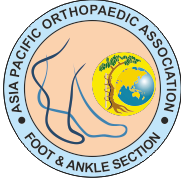Virtual Fellowship 2025
General Discussion
Tumors
Wiki error: Section name cannot be repeated 'Management'
Table of contents
1. General Characteristics and Prevalence [edit]
2. Benign Orthopaedic Tumors [edit]
2.1. Common Bone Tumors
2.2. Common Soft Tissue Lesions (often "tumor-like")
2.3. Management
3. Malignant Orthopaedic Tumors [edit]
Orthopaedic tumors of the foot and ankle, though relatively rare compared to other skeletal sites, present a significant challenge due to the complex anatomy and the potential for delayed diagnosis. The vast majority of these lesions are benign (non-cancerous), but malignant tumors require prompt and specialized management.
General Characteristics and Prevalence [edit]
Tumors in the foot and ankle account for a small percentage (around 4-5%) of all musculoskeletal tumors.3Key characteristics include:
Rarity: Foot and ankle tumors are uncommon, which can contribute to misdiagnosis or delayed diagnosis.
Benign Predominance: Approximately 75% to 85% of bone tumors in this region are benign. Soft tissue masses are also commonly benign, with the ganglion cyst being the most frequent "tumor-like" lesion.
Common Locations: The calcaneus (heel bone) is the most frequently affected bone, followed by the metatarsals and phalanges.
Benign Orthopaedic Tumors [edit]
Benign tumors of the foot and ankle are much more common and typically have a favorable prognosis after appropriate treatment.
Common Bone Tumors
Enchondroma: A non-cancerous growth of cartilage within the bone. They are often found in the small bones of the foot (phalanges and metatarsals).
Osteochondroma (Exostosis): A common, cartilage-capped bony projection growing outward from the surface of the bone.
Osteoid Osteoma: A small, benign tumor characterized by a central "nidus" that often causes night painthat is classically relieved by NSAIDs (Non-Steroidal Anti-inflammatory Drugs). It commonly affects the talus.
Simple Bone Cyst (Unicameral Bone Cyst): A fluid-filled lesion that may cause a pathological fracture. They are often seen in the calcaneus.
Common Soft Tissue Lesions (often "tumor-like")
Ganglion Cyst: The most frequent soft tissue mass, arising from a joint capsule or tendon sheath.They are filled with thick, jelly-like synovial fluid.
Plantar Fibromatosis (Ledderhose's Disease): A nodular thickening of the plantar fascia on the sole of the foot.
Management
Treatment for benign tumors ranges from observation (for asymptomatic, stable lesions like small enchondromas or ganglion cysts) to surgical excision (curettage or en-bloc resection), often followed by bone grafting or cementation to fill the resulting defect and prevent fracture.
Malignant Orthopaedic Tumors [edit]
Malignant tumors (cancers) of the foot and ankle are rare, but when they occur, they demand aggressive, multidisciplinary care. Symptoms can be non-specific, often presenting as a mass with or without pain, which can lead to delayed specialist referral.
Common Malignant Bone Tumors
Chondrosarcoma: The most common primary malignant bone tumor of the foot, especially in patients over 40. It is a cancer composed of cartilage-producing cells.
Osteosarcoma: The second most common primary bone cancer overall, it can occur in the foot, often in younger patients.
Ewing's Sarcoma: A highly malignant tumor that typically affects adolescents and young adults.
Metastases: While less common than in the spine or other long bones, metastatic lesions (cancer that has spread from another primary site like lung, kidney, or colon) can occur in the foot and ankle.
Common Malignant Soft Tissue Tumors (Sarcomas)
Synovial Sarcoma: One of the most frequent soft tissue sarcomas in this location.
Epithelioid Sarcoma and Clear Cell Sarcoma: These types of sarcomas show a relative predilection for the distal extremities, including the foot and ankle.
Management
Treatment for malignant tumors is complex and involves a multidisciplinary team (orthopedic oncologist, medical oncologist, radiation oncologist). The goal is to cure the cancer and preserve function, if possible:
Chemotherapy and/or Radiation: Often used before (neoadjuvant) or after (adjuvant) surgery to shrink the tumor and eliminate microscopic disease.
Surgical Resection: The primary goal is wide surgical margin, meaning the complete removal of the tumor along with a surrounding cuff of healthy tissue to minimize local recurrence.
Limb Salvage Surgery: Removal of the cancerous bone and replacement with a custom metallic implant, allograft (donated bone), or a fusion (arthrodesis) to preserve the limb.
Amputation: May be necessary in cases of very large tumors, widespread involvement of neurovascular structures, or when a clear margin cannot be achieved without sacrificing critical structures.
| Feature | Benign Tumors | Malignant Tumors |
| Prevalence | Most common (75-85% of bone tumors) | Rare (15-25% of bone tumors) |
| Bone Destruction | Geographic (well-defined, distinct borders) | Moth-eaten or Permeative (ill-defined, aggressive borders) |
| Periosteal Reaction | Thick, uniform, solid (slow growth) | Codman's triangle, Sunburst, Onion peel (rapid/aggressive growth) |
| Pain | Often absent or mild; night pain relieved by NSAIDs (e.g., Osteoid Osteoma) | Pain often persistent, worsening at night, and notrelieved by NSAIDs |
| Treatment | Observation, Curettage/Excision, Bone Grafting | Multi-modality: Surgery (Wide Resection/Limb Salvage or Amputation), Chemotherapy, Radiation |

